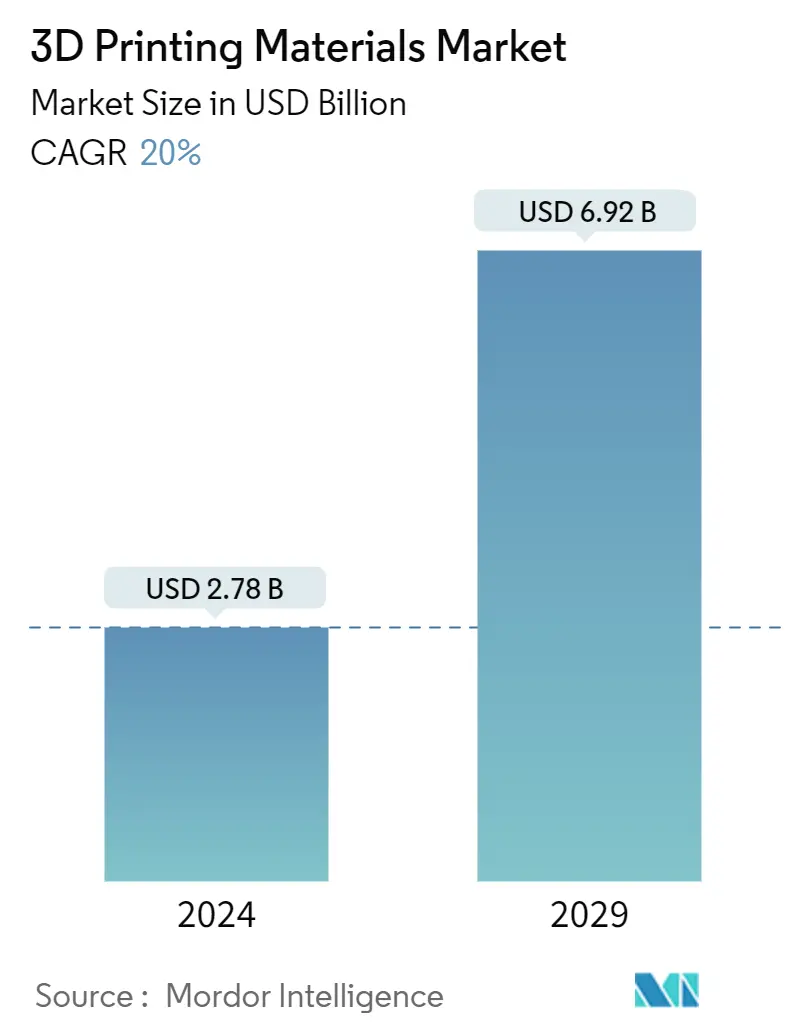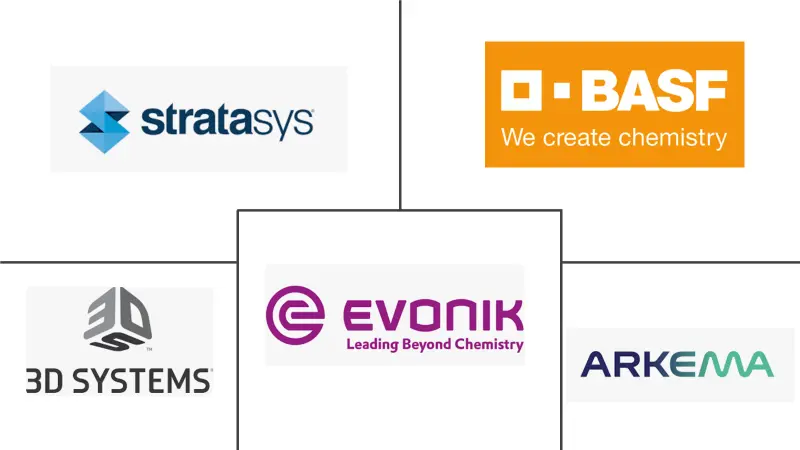Market Size of 3D Printing Materials Industry

| Study Period | 2019 - 2029 |
| Market Size (2024) | USD 2.78 Billion |
| Market Size (2029) | USD 6.92 Billion |
| CAGR (2024 - 2029) | 20.00 % |
| Fastest Growing Market | Asia Pacific |
| Largest Market | North America |
Major Players
*Disclaimer: Major Players sorted in no particular order |
3D Printing Materials Market Analysis
The 3D Printing Materials Market size is estimated at USD 2.78 billion in 2024, and is expected to reach USD 6.92 billion by 2029, growing at a CAGR of 20% during the forecast period (2024-2029).
With the outbreak of the COVID-19 pandemic, the 3D printing materials market suffered due to the disruption in the supply chain, resulting in delays in several projects. Moreover, disrupted financial flows and strict lockdowns in various countries, resulting in growing absenteeism among production line workers, affected the market adversely. However, the market rebounded in 2021 due to increased demand from the automotive industry.
- The major factors driving the market growth are the surge in demand for manufacturing applications, mass customization associated with 3D printing, and the surge in demand for automotive applications.
- On the flip side, high equipment and material costs and limited materials availability will likely hinder the market's growth.
- Introducing new materials, like graphene, opens up new applications, and adopting 3D printing technology in home printing is expected to create new opportunities for the 3D printing materials market.
3D Printing Materials Industry Segmentation
3D printing materials are generally used in 3D printing applications, such as manufacturing different parts using a computer-created design. 3D printing materials have distinctive properties, textures, features, and types that allow for choices for the particular project. The 3D printing materials market is segmented by material type, form, end-user industry, and geography. By material type, the market is segmented into plastics (acrylonitrile butadiene styrene (ABS), polylactic acid (PLA), nylon, polyamide, polycarbonates, and other plastics), ceramics, metals, and other material types. The market is segmented by form into powder, filament, and liquid. The end-user industry segments the market into automotive, medical, aerospace and defense, consumer electronics, and other industries. The report also covers the market sizes and forecasts for the 3D printing materials market in 17 countries across the major regions. Market sizing and forecasts have been done for each segment based on revenue (USD).
| Material Type | ||||||||
| ||||||||
| Ceramics | ||||||||
| Metals | ||||||||
| Other Material Types |
| Form | |
| Powder | |
| Filament | |
| Liquid |
| End-user Industry | |
| Automotive | |
| Medical | |
| Aerospace and Defense | |
| Consumer Electronics | |
| Other End-user Industries |
| Geography | ||||||||
| ||||||||
| ||||||||
| ||||||||
| ||||||||
|
3D Printing Materials Market Size Summary
The 3D printing materials market is poised for significant growth, driven by increasing demand across various sectors, particularly automotive and electronics. The market, which experienced disruptions due to the COVID-19 pandemic, has shown resilience and is expected to expand substantially over the forecast period. Key factors contributing to this growth include the rising need for manufacturing applications, the benefits of mass customization, and the adoption of 3D printing technologies in automotive production. Despite challenges such as high costs and limited material availability, innovations like graphene and the integration of 3D printing in home applications are creating new opportunities. The automotive industry, with its focus on rapid prototyping and reduced manufacturing costs, is a major consumer of 3D printing materials, with significant contributions from leading manufacturers globally.
The Asia-Pacific region, particularly China, is a significant driver of market growth due to its robust automotive sector and increasing adoption of electric vehicles. The region's expanding population and rising living standards further bolster demand for 3D printing materials. In addition to automotive applications, the construction industry in China is exploring 3D printing technologies, which could revolutionize traditional building methods. Despite some limitations in the construction sector, the potential for cost savings and efficiency is encouraging adoption. The market is consolidated, with major players like Stratasys, BASF SE, and 3D Systems Inc. leading the way through strategic acquisitions and product innovations, further enhancing their market positions.
3D Printing Materials Market Size - Table of Contents
-
1. MARKET DYNAMICS
-
1.1 Drivers
-
1.1.1 Growing Usage in Manufacturing Applications
-
1.1.2 Mass Customization Associated with 3D Printing
-
1.1.3 Surge in Demand in Automotive Application
-
-
1.2 Restraints
-
1.2.1 High Equipment and Material Cost
-
1.2.2 Availability of Limited Types of Materials
-
-
1.3 Industry Value Chain Analysis
-
1.4 Porter's Five Forces Analysis
-
1.4.1 Bargaining Power of Suppliers
-
1.4.2 Bargaining Power of Consumers
-
1.4.3 Threat of New Entrants
-
1.4.4 Threat of Substitute Products and Services
-
1.4.5 Degree of Competition
-
-
-
2. MARKET SEGMENTATION (Market Size in Value)
-
2.1 Material Type
-
2.1.1 Plastics
-
2.1.1.1 Acrylonitrile Butadiene Styrene (ABS)
-
2.1.1.2 Polylactic Acid (PLA)
-
2.1.1.3 Nylon
-
2.1.1.4 Polyamide
-
2.1.1.5 Polycarbonates
-
2.1.1.6 Other Plastics
-
-
2.1.2 Ceramics
-
2.1.3 Metals
-
2.1.4 Other Material Types
-
-
2.2 Form
-
2.2.1 Powder
-
2.2.2 Filament
-
2.2.3 Liquid
-
-
2.3 End-user Industry
-
2.3.1 Automotive
-
2.3.2 Medical
-
2.3.3 Aerospace and Defense
-
2.3.4 Consumer Electronics
-
2.3.5 Other End-user Industries
-
-
2.4 Geography
-
2.4.1 Asia-Pacific
-
2.4.1.1 China
-
2.4.1.2 India
-
2.4.1.3 Japan
-
2.4.1.4 South Korea
-
2.4.1.5 Singapore
-
2.4.1.6 Rest of Asia-Pacific
-
-
2.4.2 North America
-
2.4.2.1 United States
-
2.4.2.2 Canada
-
2.4.2.3 Mexico
-
-
2.4.3 Europe
-
2.4.3.1 Germany
-
2.4.3.2 United Kingdom
-
2.4.3.3 Italy
-
2.4.3.4 France
-
2.4.3.5 Russia
-
2.4.3.6 Rest of Europe
-
-
2.4.4 South America
-
2.4.4.1 Brazil
-
2.4.4.2 Argentina
-
2.4.4.3 Rest of South America
-
-
2.4.5 Middle-East and Africa
-
2.4.5.1 Saudi Arabia
-
2.4.5.2 South Africa
-
2.4.5.3 Rest of Middle-East and Africa
-
-
-
3D Printing Materials Market Size FAQs
How big is the 3D Printing Materials Market?
The 3D Printing Materials Market size is expected to reach USD 2.78 billion in 2024 and grow at a CAGR of 20% to reach USD 6.92 billion by 2029.
What is the current 3D Printing Materials Market size?
In 2024, the 3D Printing Materials Market size is expected to reach USD 2.78 billion.

